Project Quality Issues: Boeing 737 Max & Supermarket Construction
VerifiedAdded on 2022/09/27
|26
|7484
|27
Case Study
AI Summary
This assignment delves into project quality management, using the Boeing 737 Max airplane and a new supermarket construction project as case studies. The analysis of the Boeing 737 Max focuses on the failure to comply with established project quality processes, particularly highlighting the MCAS software and its role in the crashes. It discusses the importance of quality management principles, proper documentation, and thorough testing and training. The second part compares and contrasts the roles of quality assurance and quality control in a construction project. It emphasizes the proactive nature of quality assurance in establishing processes and standards, while quality control focuses on verifying that the end product meets those standards. The document references relevant academic research to support its arguments, providing a comprehensive overview of project quality issues and management strategies.
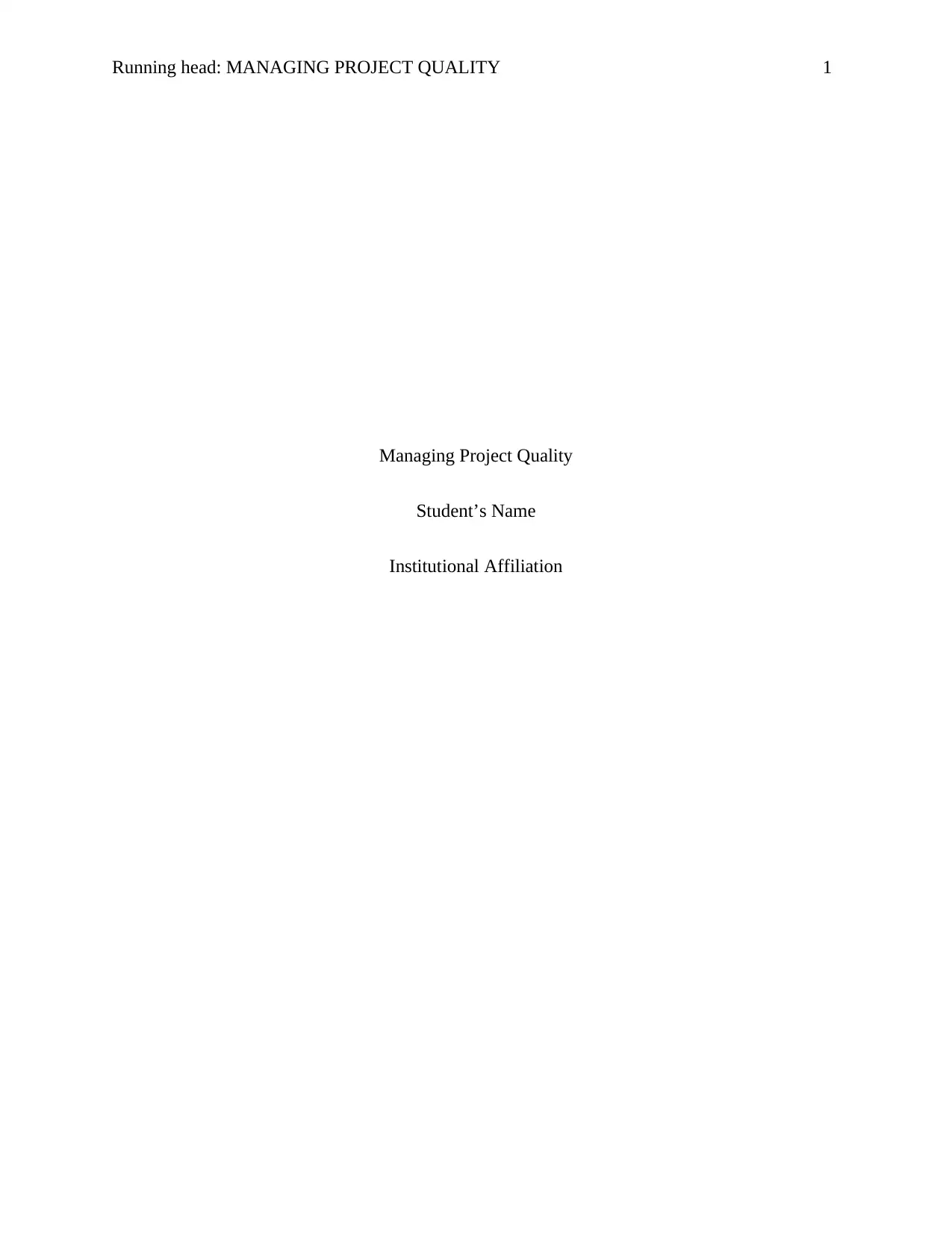
Running head: MANAGING PROJECT QUALITY 1
Managing Project Quality
Student’s Name
Institutional Affiliation
Managing Project Quality
Student’s Name
Institutional Affiliation
Paraphrase This Document
Need a fresh take? Get an instant paraphrase of this document with our AI Paraphraser
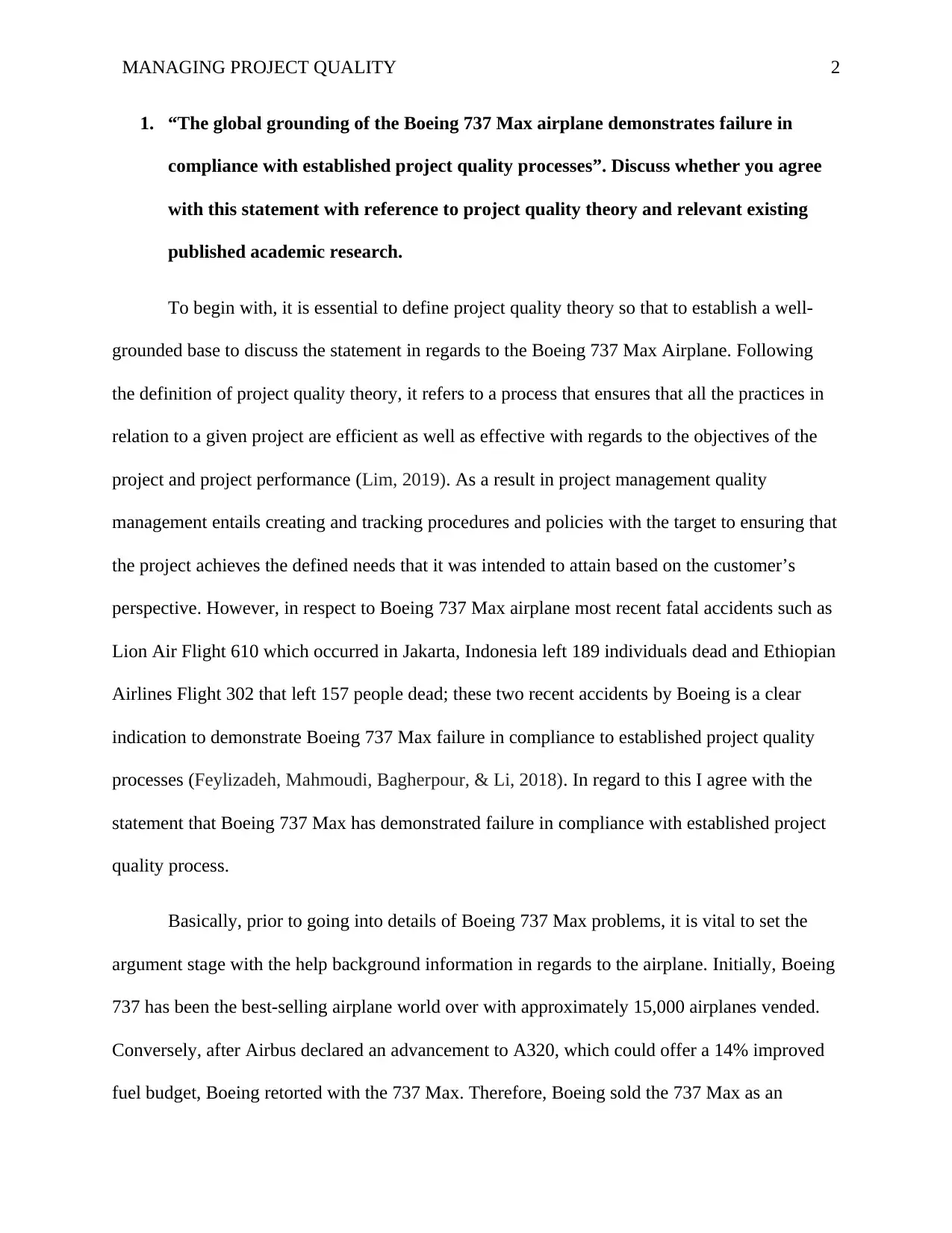
MANAGING PROJECT QUALITY 2
1. “The global grounding of the Boeing 737 Max airplane demonstrates failure in
compliance with established project quality processes”. Discuss whether you agree
with this statement with reference to project quality theory and relevant existing
published academic research.
To begin with, it is essential to define project quality theory so that to establish a well-
grounded base to discuss the statement in regards to the Boeing 737 Max Airplane. Following
the definition of project quality theory, it refers to a process that ensures that all the practices in
relation to a given project are efficient as well as effective with regards to the objectives of the
project and project performance (Lim, 2019). As a result in project management quality
management entails creating and tracking procedures and policies with the target to ensuring that
the project achieves the defined needs that it was intended to attain based on the customer’s
perspective. However, in respect to Boeing 737 Max airplane most recent fatal accidents such as
Lion Air Flight 610 which occurred in Jakarta, Indonesia left 189 individuals dead and Ethiopian
Airlines Flight 302 that left 157 people dead; these two recent accidents by Boeing is a clear
indication to demonstrate Boeing 737 Max failure in compliance to established project quality
processes (Feylizadeh, Mahmoudi, Bagherpour, & Li, 2018). In regard to this I agree with the
statement that Boeing 737 Max has demonstrated failure in compliance with established project
quality process.
Basically, prior to going into details of Boeing 737 Max problems, it is vital to set the
argument stage with the help background information in regards to the airplane. Initially, Boeing
737 has been the best-selling airplane world over with approximately 15,000 airplanes vended.
Conversely, after Airbus declared an advancement to A320, which could offer a 14% improved
fuel budget, Boeing retorted with the 737 Max. Therefore, Boeing sold the 737 Max as an
1. “The global grounding of the Boeing 737 Max airplane demonstrates failure in
compliance with established project quality processes”. Discuss whether you agree
with this statement with reference to project quality theory and relevant existing
published academic research.
To begin with, it is essential to define project quality theory so that to establish a well-
grounded base to discuss the statement in regards to the Boeing 737 Max Airplane. Following
the definition of project quality theory, it refers to a process that ensures that all the practices in
relation to a given project are efficient as well as effective with regards to the objectives of the
project and project performance (Lim, 2019). As a result in project management quality
management entails creating and tracking procedures and policies with the target to ensuring that
the project achieves the defined needs that it was intended to attain based on the customer’s
perspective. However, in respect to Boeing 737 Max airplane most recent fatal accidents such as
Lion Air Flight 610 which occurred in Jakarta, Indonesia left 189 individuals dead and Ethiopian
Airlines Flight 302 that left 157 people dead; these two recent accidents by Boeing is a clear
indication to demonstrate Boeing 737 Max failure in compliance to established project quality
processes (Feylizadeh, Mahmoudi, Bagherpour, & Li, 2018). In regard to this I agree with the
statement that Boeing 737 Max has demonstrated failure in compliance with established project
quality process.
Basically, prior to going into details of Boeing 737 Max problems, it is vital to set the
argument stage with the help background information in regards to the airplane. Initially, Boeing
737 has been the best-selling airplane world over with approximately 15,000 airplanes vended.
Conversely, after Airbus declared an advancement to A320, which could offer a 14% improved
fuel budget, Boeing retorted with the 737 Max. Therefore, Boeing sold the 737 Max as an
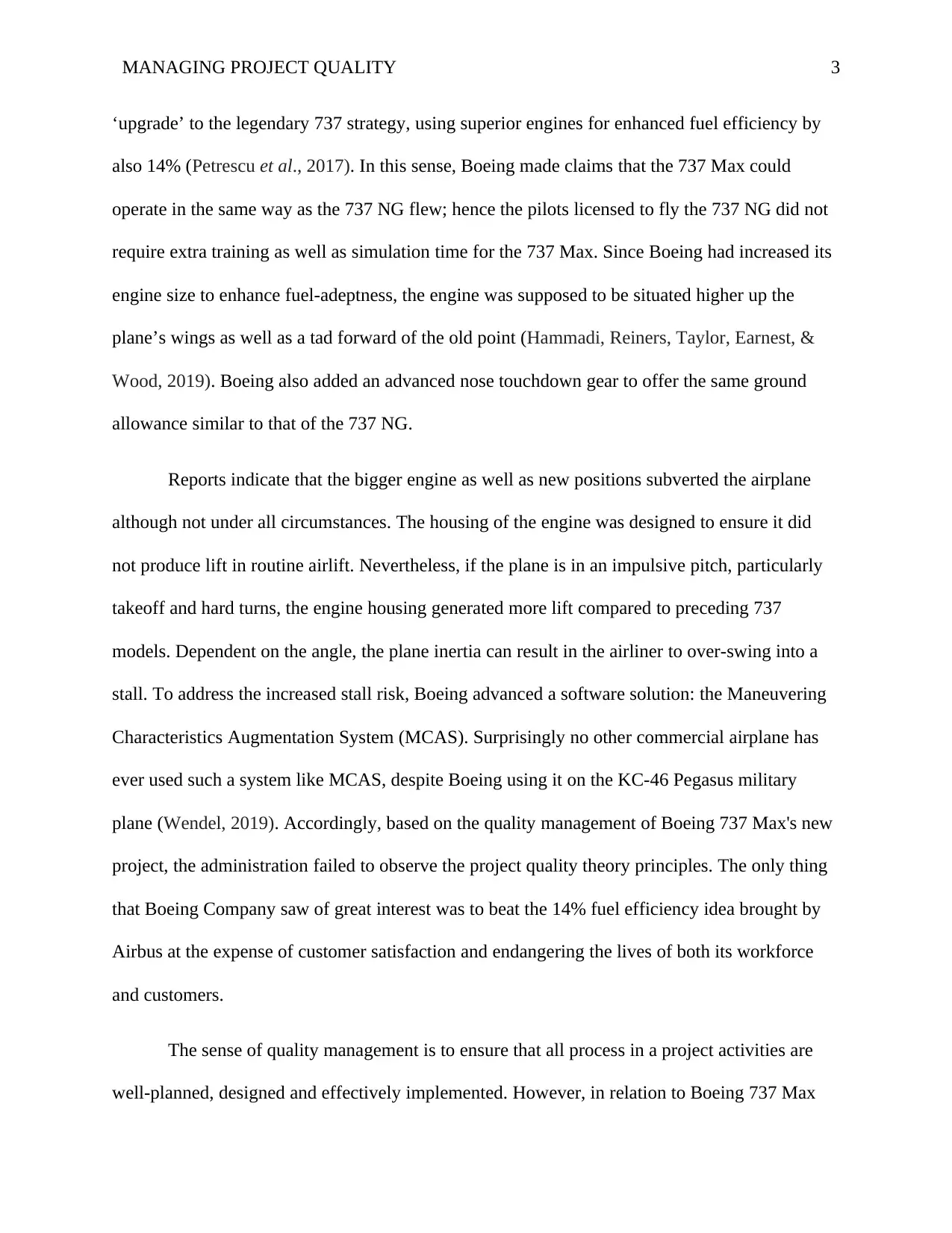
MANAGING PROJECT QUALITY 3
‘upgrade’ to the legendary 737 strategy, using superior engines for enhanced fuel efficiency by
also 14% (Petrescu et al., 2017). In this sense, Boeing made claims that the 737 Max could
operate in the same way as the 737 NG flew; hence the pilots licensed to fly the 737 NG did not
require extra training as well as simulation time for the 737 Max. Since Boeing had increased its
engine size to enhance fuel-adeptness, the engine was supposed to be situated higher up the
plane’s wings as well as a tad forward of the old point (Hammadi, Reiners, Taylor, Earnest, &
Wood, 2019). Boeing also added an advanced nose touchdown gear to offer the same ground
allowance similar to that of the 737 NG.
Reports indicate that the bigger engine as well as new positions subverted the airplane
although not under all circumstances. The housing of the engine was designed to ensure it did
not produce lift in routine airlift. Nevertheless, if the plane is in an impulsive pitch, particularly
takeoff and hard turns, the engine housing generated more lift compared to preceding 737
models. Dependent on the angle, the plane inertia can result in the airliner to over-swing into a
stall. To address the increased stall risk, Boeing advanced a software solution: the Maneuvering
Characteristics Augmentation System (MCAS). Surprisingly no other commercial airplane has
ever used such a system like MCAS, despite Boeing using it on the KC-46 Pegasus military
plane (Wendel, 2019). Accordingly, based on the quality management of Boeing 737 Max's new
project, the administration failed to observe the project quality theory principles. The only thing
that Boeing Company saw of great interest was to beat the 14% fuel efficiency idea brought by
Airbus at the expense of customer satisfaction and endangering the lives of both its workforce
and customers.
The sense of quality management is to ensure that all process in a project activities are
well-planned, designed and effectively implemented. However, in relation to Boeing 737 Max
‘upgrade’ to the legendary 737 strategy, using superior engines for enhanced fuel efficiency by
also 14% (Petrescu et al., 2017). In this sense, Boeing made claims that the 737 Max could
operate in the same way as the 737 NG flew; hence the pilots licensed to fly the 737 NG did not
require extra training as well as simulation time for the 737 Max. Since Boeing had increased its
engine size to enhance fuel-adeptness, the engine was supposed to be situated higher up the
plane’s wings as well as a tad forward of the old point (Hammadi, Reiners, Taylor, Earnest, &
Wood, 2019). Boeing also added an advanced nose touchdown gear to offer the same ground
allowance similar to that of the 737 NG.
Reports indicate that the bigger engine as well as new positions subverted the airplane
although not under all circumstances. The housing of the engine was designed to ensure it did
not produce lift in routine airlift. Nevertheless, if the plane is in an impulsive pitch, particularly
takeoff and hard turns, the engine housing generated more lift compared to preceding 737
models. Dependent on the angle, the plane inertia can result in the airliner to over-swing into a
stall. To address the increased stall risk, Boeing advanced a software solution: the Maneuvering
Characteristics Augmentation System (MCAS). Surprisingly no other commercial airplane has
ever used such a system like MCAS, despite Boeing using it on the KC-46 Pegasus military
plane (Wendel, 2019). Accordingly, based on the quality management of Boeing 737 Max's new
project, the administration failed to observe the project quality theory principles. The only thing
that Boeing Company saw of great interest was to beat the 14% fuel efficiency idea brought by
Airbus at the expense of customer satisfaction and endangering the lives of both its workforce
and customers.
The sense of quality management is to ensure that all process in a project activities are
well-planned, designed and effectively implemented. However, in relation to Boeing 737 Max
⊘ This is a preview!⊘
Do you want full access?
Subscribe today to unlock all pages.

Trusted by 1+ million students worldwide
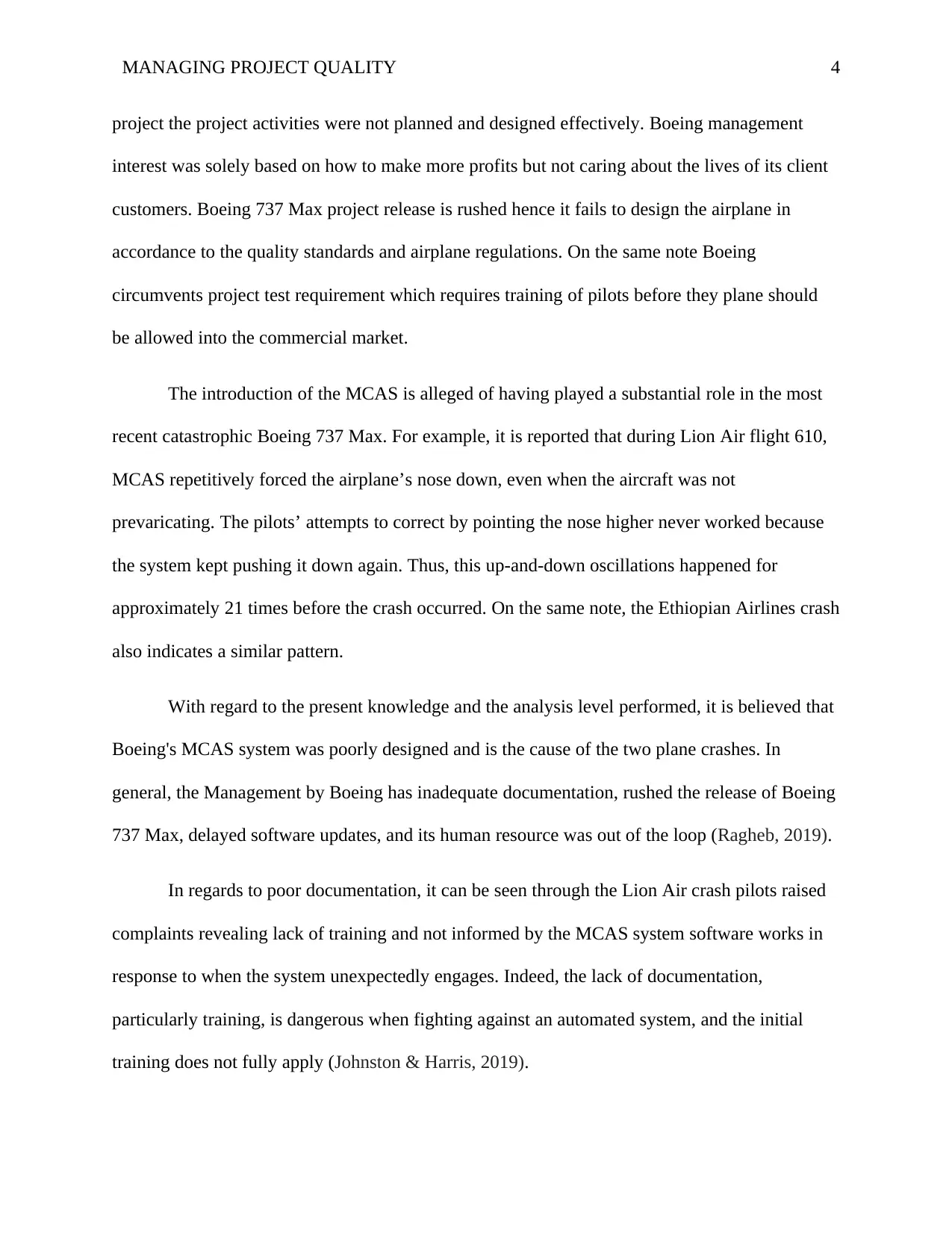
MANAGING PROJECT QUALITY 4
project the project activities were not planned and designed effectively. Boeing management
interest was solely based on how to make more profits but not caring about the lives of its client
customers. Boeing 737 Max project release is rushed hence it fails to design the airplane in
accordance to the quality standards and airplane regulations. On the same note Boeing
circumvents project test requirement which requires training of pilots before they plane should
be allowed into the commercial market.
The introduction of the MCAS is alleged of having played a substantial role in the most
recent catastrophic Boeing 737 Max. For example, it is reported that during Lion Air flight 610,
MCAS repetitively forced the airplane’s nose down, even when the aircraft was not
prevaricating. The pilots’ attempts to correct by pointing the nose higher never worked because
the system kept pushing it down again. Thus, this up-and-down oscillations happened for
approximately 21 times before the crash occurred. On the same note, the Ethiopian Airlines crash
also indicates a similar pattern.
With regard to the present knowledge and the analysis level performed, it is believed that
Boeing's MCAS system was poorly designed and is the cause of the two plane crashes. In
general, the Management by Boeing has inadequate documentation, rushed the release of Boeing
737 Max, delayed software updates, and its human resource was out of the loop (Ragheb, 2019).
In regards to poor documentation, it can be seen through the Lion Air crash pilots raised
complaints revealing lack of training and not informed by the MCAS system software works in
response to when the system unexpectedly engages. Indeed, the lack of documentation,
particularly training, is dangerous when fighting against an automated system, and the initial
training does not fully apply (Johnston & Harris, 2019).
project the project activities were not planned and designed effectively. Boeing management
interest was solely based on how to make more profits but not caring about the lives of its client
customers. Boeing 737 Max project release is rushed hence it fails to design the airplane in
accordance to the quality standards and airplane regulations. On the same note Boeing
circumvents project test requirement which requires training of pilots before they plane should
be allowed into the commercial market.
The introduction of the MCAS is alleged of having played a substantial role in the most
recent catastrophic Boeing 737 Max. For example, it is reported that during Lion Air flight 610,
MCAS repetitively forced the airplane’s nose down, even when the aircraft was not
prevaricating. The pilots’ attempts to correct by pointing the nose higher never worked because
the system kept pushing it down again. Thus, this up-and-down oscillations happened for
approximately 21 times before the crash occurred. On the same note, the Ethiopian Airlines crash
also indicates a similar pattern.
With regard to the present knowledge and the analysis level performed, it is believed that
Boeing's MCAS system was poorly designed and is the cause of the two plane crashes. In
general, the Management by Boeing has inadequate documentation, rushed the release of Boeing
737 Max, delayed software updates, and its human resource was out of the loop (Ragheb, 2019).
In regards to poor documentation, it can be seen through the Lion Air crash pilots raised
complaints revealing lack of training and not informed by the MCAS system software works in
response to when the system unexpectedly engages. Indeed, the lack of documentation,
particularly training, is dangerous when fighting against an automated system, and the initial
training does not fully apply (Johnston & Harris, 2019).
Paraphrase This Document
Need a fresh take? Get an instant paraphrase of this document with our AI Paraphraser
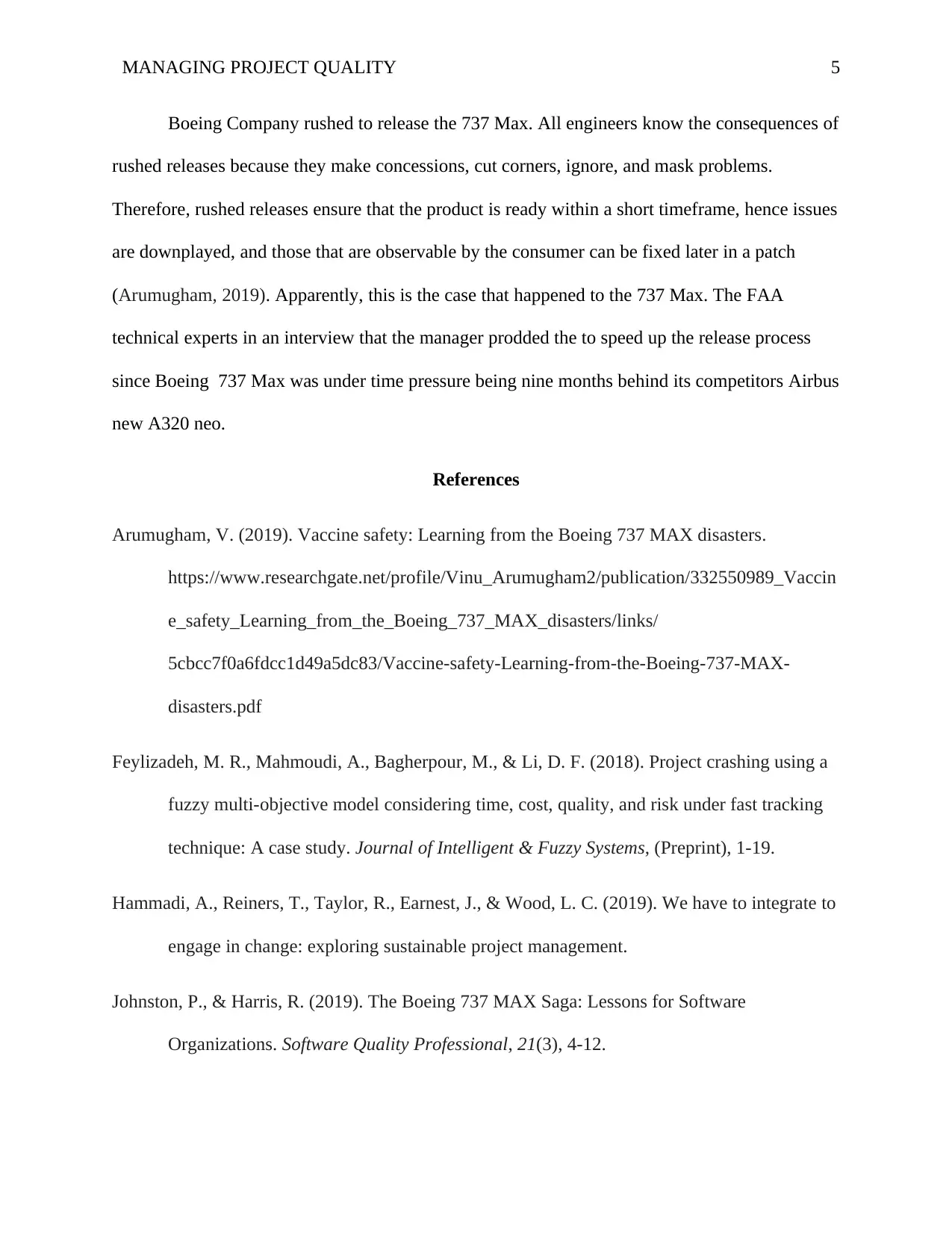
MANAGING PROJECT QUALITY 5
Boeing Company rushed to release the 737 Max. All engineers know the consequences of
rushed releases because they make concessions, cut corners, ignore, and mask problems.
Therefore, rushed releases ensure that the product is ready within a short timeframe, hence issues
are downplayed, and those that are observable by the consumer can be fixed later in a patch
(Arumugham, 2019). Apparently, this is the case that happened to the 737 Max. The FAA
technical experts in an interview that the manager prodded the to speed up the release process
since Boeing 737 Max was under time pressure being nine months behind its competitors Airbus
new A320 neo.
References
Arumugham, V. (2019). Vaccine safety: Learning from the Boeing 737 MAX disasters.
https://www.researchgate.net/profile/Vinu_Arumugham2/publication/332550989_Vaccin
e_safety_Learning_from_the_Boeing_737_MAX_disasters/links/
5cbcc7f0a6fdcc1d49a5dc83/Vaccine-safety-Learning-from-the-Boeing-737-MAX-
disasters.pdf
Feylizadeh, M. R., Mahmoudi, A., Bagherpour, M., & Li, D. F. (2018). Project crashing using a
fuzzy multi-objective model considering time, cost, quality, and risk under fast tracking
technique: A case study. Journal of Intelligent & Fuzzy Systems, (Preprint), 1-19.
Hammadi, A., Reiners, T., Taylor, R., Earnest, J., & Wood, L. C. (2019). We have to integrate to
engage in change: exploring sustainable project management.
Johnston, P., & Harris, R. (2019). The Boeing 737 MAX Saga: Lessons for Software
Organizations. Software Quality Professional, 21(3), 4-12.
Boeing Company rushed to release the 737 Max. All engineers know the consequences of
rushed releases because they make concessions, cut corners, ignore, and mask problems.
Therefore, rushed releases ensure that the product is ready within a short timeframe, hence issues
are downplayed, and those that are observable by the consumer can be fixed later in a patch
(Arumugham, 2019). Apparently, this is the case that happened to the 737 Max. The FAA
technical experts in an interview that the manager prodded the to speed up the release process
since Boeing 737 Max was under time pressure being nine months behind its competitors Airbus
new A320 neo.
References
Arumugham, V. (2019). Vaccine safety: Learning from the Boeing 737 MAX disasters.
https://www.researchgate.net/profile/Vinu_Arumugham2/publication/332550989_Vaccin
e_safety_Learning_from_the_Boeing_737_MAX_disasters/links/
5cbcc7f0a6fdcc1d49a5dc83/Vaccine-safety-Learning-from-the-Boeing-737-MAX-
disasters.pdf
Feylizadeh, M. R., Mahmoudi, A., Bagherpour, M., & Li, D. F. (2018). Project crashing using a
fuzzy multi-objective model considering time, cost, quality, and risk under fast tracking
technique: A case study. Journal of Intelligent & Fuzzy Systems, (Preprint), 1-19.
Hammadi, A., Reiners, T., Taylor, R., Earnest, J., & Wood, L. C. (2019). We have to integrate to
engage in change: exploring sustainable project management.
Johnston, P., & Harris, R. (2019). The Boeing 737 MAX Saga: Lessons for Software
Organizations. Software Quality Professional, 21(3), 4-12.
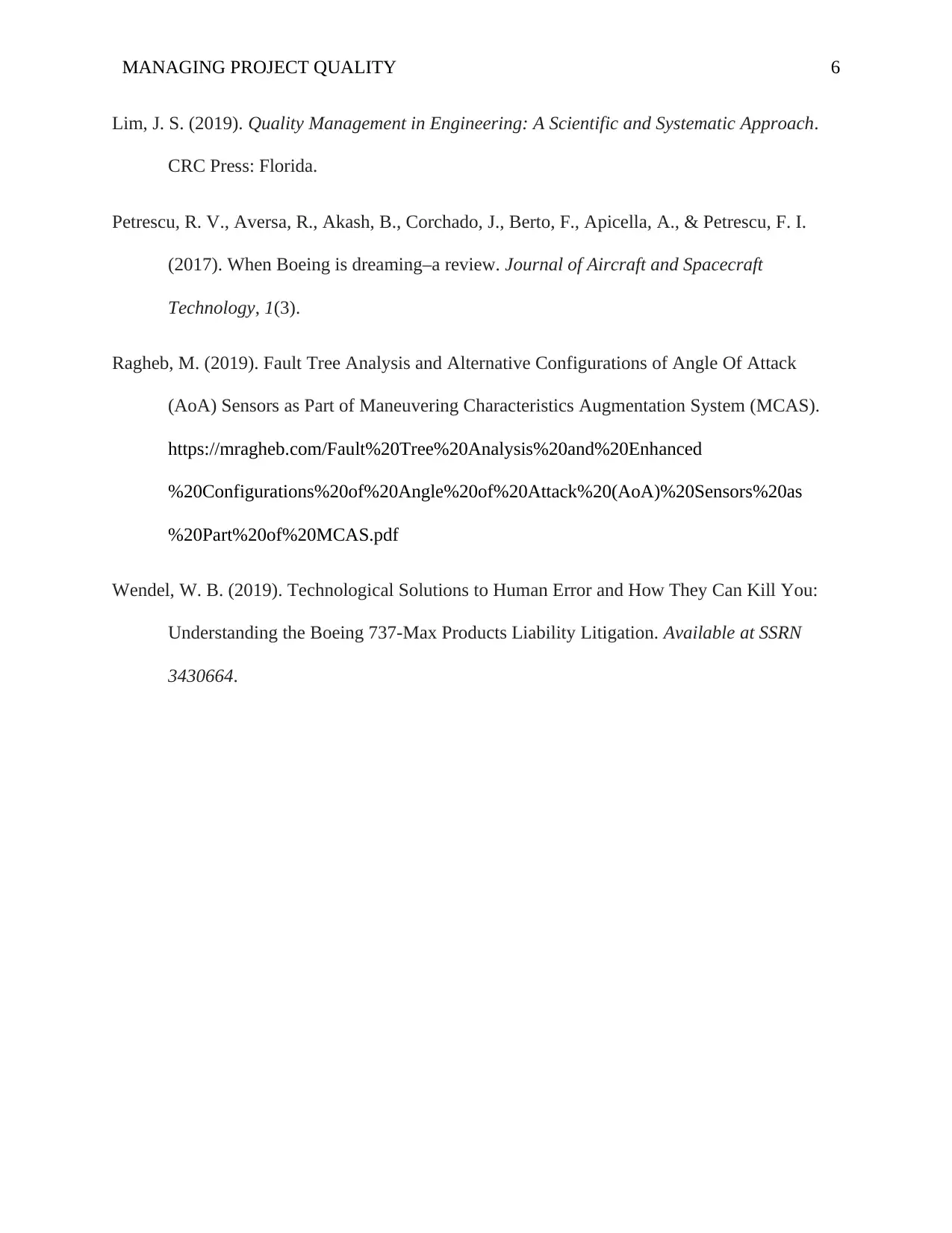
MANAGING PROJECT QUALITY 6
Lim, J. S. (2019). Quality Management in Engineering: A Scientific and Systematic Approach.
CRC Press: Florida.
Petrescu, R. V., Aversa, R., Akash, B., Corchado, J., Berto, F., Apicella, A., & Petrescu, F. I.
(2017). When Boeing is dreaming–a review. Journal of Aircraft and Spacecraft
Technology, 1(3).
Ragheb, M. (2019). Fault Tree Analysis and Alternative Configurations of Angle Of Attack
(AoA) Sensors as Part of Maneuvering Characteristics Augmentation System (MCAS).
https://mragheb.com/Fault%20Tree%20Analysis%20and%20Enhanced
%20Configurations%20of%20Angle%20of%20Attack%20(AoA)%20Sensors%20as
%20Part%20of%20MCAS.pdf
Wendel, W. B. (2019). Technological Solutions to Human Error and How They Can Kill You:
Understanding the Boeing 737-Max Products Liability Litigation. Available at SSRN
3430664.
Lim, J. S. (2019). Quality Management in Engineering: A Scientific and Systematic Approach.
CRC Press: Florida.
Petrescu, R. V., Aversa, R., Akash, B., Corchado, J., Berto, F., Apicella, A., & Petrescu, F. I.
(2017). When Boeing is dreaming–a review. Journal of Aircraft and Spacecraft
Technology, 1(3).
Ragheb, M. (2019). Fault Tree Analysis and Alternative Configurations of Angle Of Attack
(AoA) Sensors as Part of Maneuvering Characteristics Augmentation System (MCAS).
https://mragheb.com/Fault%20Tree%20Analysis%20and%20Enhanced
%20Configurations%20of%20Angle%20of%20Attack%20(AoA)%20Sensors%20as
%20Part%20of%20MCAS.pdf
Wendel, W. B. (2019). Technological Solutions to Human Error and How They Can Kill You:
Understanding the Boeing 737-Max Products Liability Litigation. Available at SSRN
3430664.
⊘ This is a preview!⊘
Do you want full access?
Subscribe today to unlock all pages.

Trusted by 1+ million students worldwide
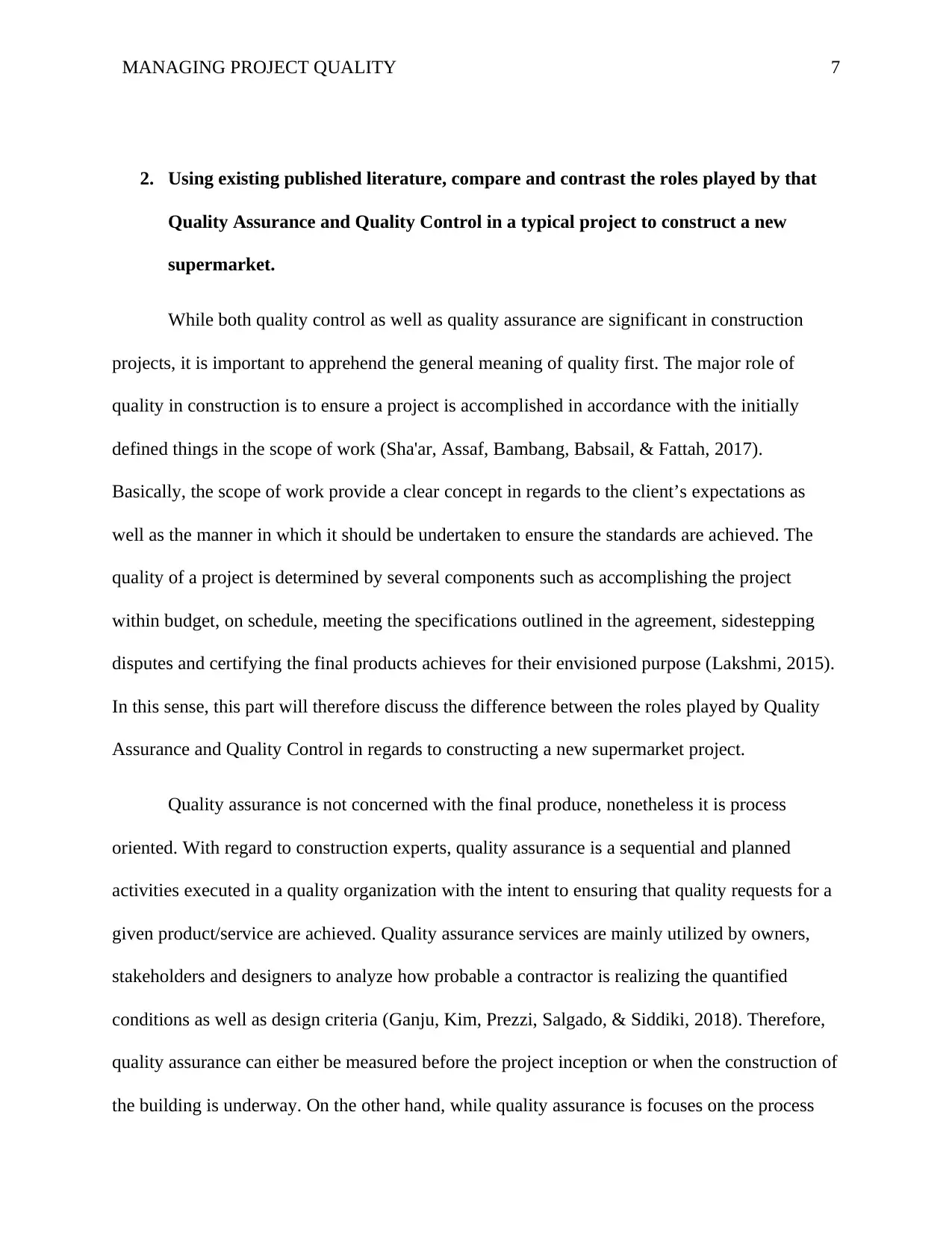
MANAGING PROJECT QUALITY 7
2. Using existing published literature, compare and contrast the roles played by that
Quality Assurance and Quality Control in a typical project to construct a new
supermarket.
While both quality control as well as quality assurance are significant in construction
projects, it is important to apprehend the general meaning of quality first. The major role of
quality in construction is to ensure a project is accomplished in accordance with the initially
defined things in the scope of work (Sha'ar, Assaf, Bambang, Babsail, & Fattah, 2017).
Basically, the scope of work provide a clear concept in regards to the client’s expectations as
well as the manner in which it should be undertaken to ensure the standards are achieved. The
quality of a project is determined by several components such as accomplishing the project
within budget, on schedule, meeting the specifications outlined in the agreement, sidestepping
disputes and certifying the final products achieves for their envisioned purpose (Lakshmi, 2015).
In this sense, this part will therefore discuss the difference between the roles played by Quality
Assurance and Quality Control in regards to constructing a new supermarket project.
Quality assurance is not concerned with the final produce, nonetheless it is process
oriented. With regard to construction experts, quality assurance is a sequential and planned
activities executed in a quality organization with the intent to ensuring that quality requests for a
given product/service are achieved. Quality assurance services are mainly utilized by owners,
stakeholders and designers to analyze how probable a contractor is realizing the quantified
conditions as well as design criteria (Ganju, Kim, Prezzi, Salgado, & Siddiki, 2018). Therefore,
quality assurance can either be measured before the project inception or when the construction of
the building is underway. On the other hand, while quality assurance is focuses on the process
2. Using existing published literature, compare and contrast the roles played by that
Quality Assurance and Quality Control in a typical project to construct a new
supermarket.
While both quality control as well as quality assurance are significant in construction
projects, it is important to apprehend the general meaning of quality first. The major role of
quality in construction is to ensure a project is accomplished in accordance with the initially
defined things in the scope of work (Sha'ar, Assaf, Bambang, Babsail, & Fattah, 2017).
Basically, the scope of work provide a clear concept in regards to the client’s expectations as
well as the manner in which it should be undertaken to ensure the standards are achieved. The
quality of a project is determined by several components such as accomplishing the project
within budget, on schedule, meeting the specifications outlined in the agreement, sidestepping
disputes and certifying the final products achieves for their envisioned purpose (Lakshmi, 2015).
In this sense, this part will therefore discuss the difference between the roles played by Quality
Assurance and Quality Control in regards to constructing a new supermarket project.
Quality assurance is not concerned with the final produce, nonetheless it is process
oriented. With regard to construction experts, quality assurance is a sequential and planned
activities executed in a quality organization with the intent to ensuring that quality requests for a
given product/service are achieved. Quality assurance services are mainly utilized by owners,
stakeholders and designers to analyze how probable a contractor is realizing the quantified
conditions as well as design criteria (Ganju, Kim, Prezzi, Salgado, & Siddiki, 2018). Therefore,
quality assurance can either be measured before the project inception or when the construction of
the building is underway. On the other hand, while quality assurance is focuses on the process
Paraphrase This Document
Need a fresh take? Get an instant paraphrase of this document with our AI Paraphraser
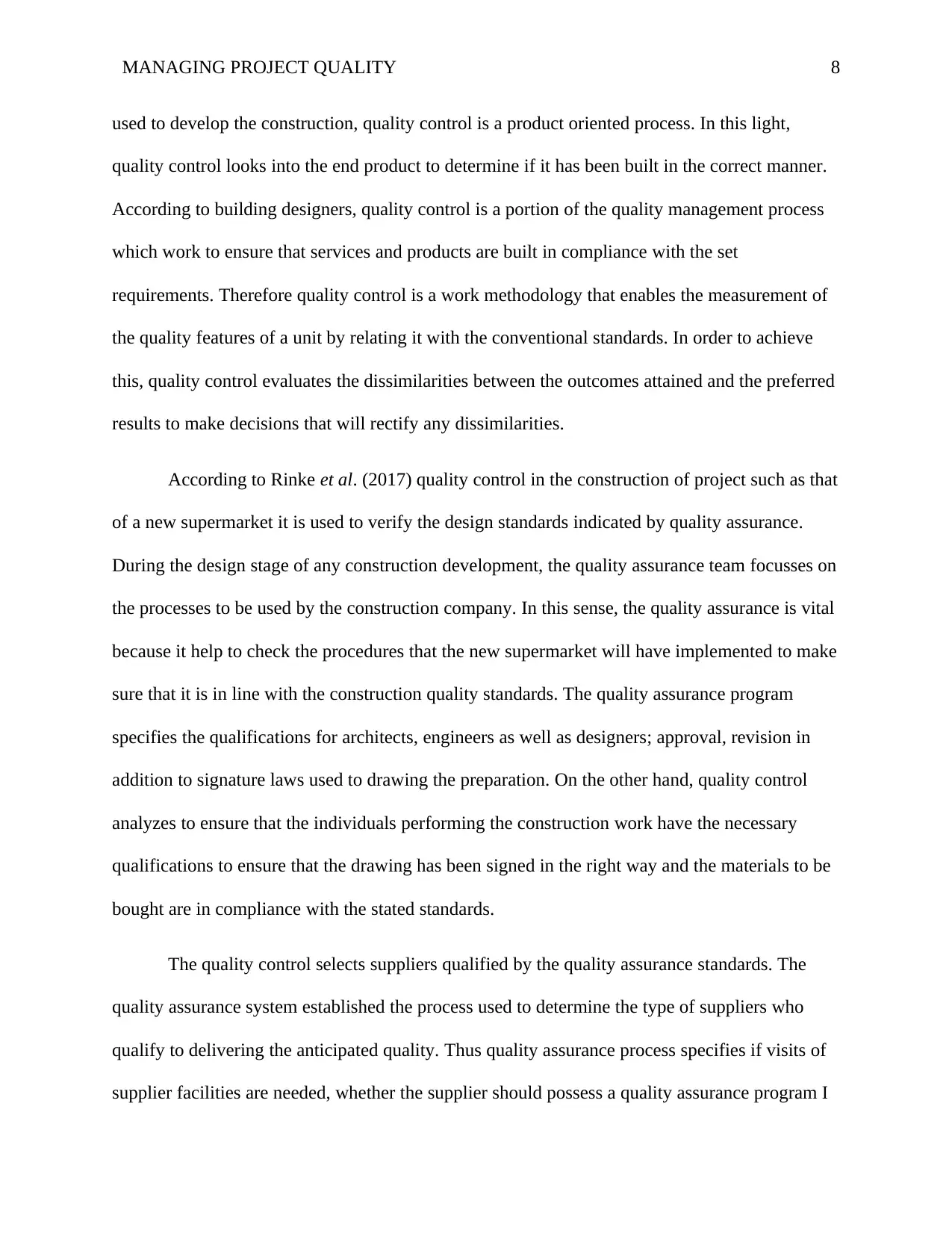
MANAGING PROJECT QUALITY 8
used to develop the construction, quality control is a product oriented process. In this light,
quality control looks into the end product to determine if it has been built in the correct manner.
According to building designers, quality control is a portion of the quality management process
which work to ensure that services and products are built in compliance with the set
requirements. Therefore quality control is a work methodology that enables the measurement of
the quality features of a unit by relating it with the conventional standards. In order to achieve
this, quality control evaluates the dissimilarities between the outcomes attained and the preferred
results to make decisions that will rectify any dissimilarities.
According to Rinke et al. (2017) quality control in the construction of project such as that
of a new supermarket it is used to verify the design standards indicated by quality assurance.
During the design stage of any construction development, the quality assurance team focusses on
the processes to be used by the construction company. In this sense, the quality assurance is vital
because it help to check the procedures that the new supermarket will have implemented to make
sure that it is in line with the construction quality standards. The quality assurance program
specifies the qualifications for architects, engineers as well as designers; approval, revision in
addition to signature laws used to drawing the preparation. On the other hand, quality control
analyzes to ensure that the individuals performing the construction work have the necessary
qualifications to ensure that the drawing has been signed in the right way and the materials to be
bought are in compliance with the stated standards.
The quality control selects suppliers qualified by the quality assurance standards. The
quality assurance system established the process used to determine the type of suppliers who
qualify to delivering the anticipated quality. Thus quality assurance process specifies if visits of
supplier facilities are needed, whether the supplier should possess a quality assurance program I
used to develop the construction, quality control is a product oriented process. In this light,
quality control looks into the end product to determine if it has been built in the correct manner.
According to building designers, quality control is a portion of the quality management process
which work to ensure that services and products are built in compliance with the set
requirements. Therefore quality control is a work methodology that enables the measurement of
the quality features of a unit by relating it with the conventional standards. In order to achieve
this, quality control evaluates the dissimilarities between the outcomes attained and the preferred
results to make decisions that will rectify any dissimilarities.
According to Rinke et al. (2017) quality control in the construction of project such as that
of a new supermarket it is used to verify the design standards indicated by quality assurance.
During the design stage of any construction development, the quality assurance team focusses on
the processes to be used by the construction company. In this sense, the quality assurance is vital
because it help to check the procedures that the new supermarket will have implemented to make
sure that it is in line with the construction quality standards. The quality assurance program
specifies the qualifications for architects, engineers as well as designers; approval, revision in
addition to signature laws used to drawing the preparation. On the other hand, quality control
analyzes to ensure that the individuals performing the construction work have the necessary
qualifications to ensure that the drawing has been signed in the right way and the materials to be
bought are in compliance with the stated standards.
The quality control selects suppliers qualified by the quality assurance standards. The
quality assurance system established the process used to determine the type of suppliers who
qualify to delivering the anticipated quality. Thus quality assurance process specifies if visits of
supplier facilities are needed, whether the supplier should possess a quality assurance program I
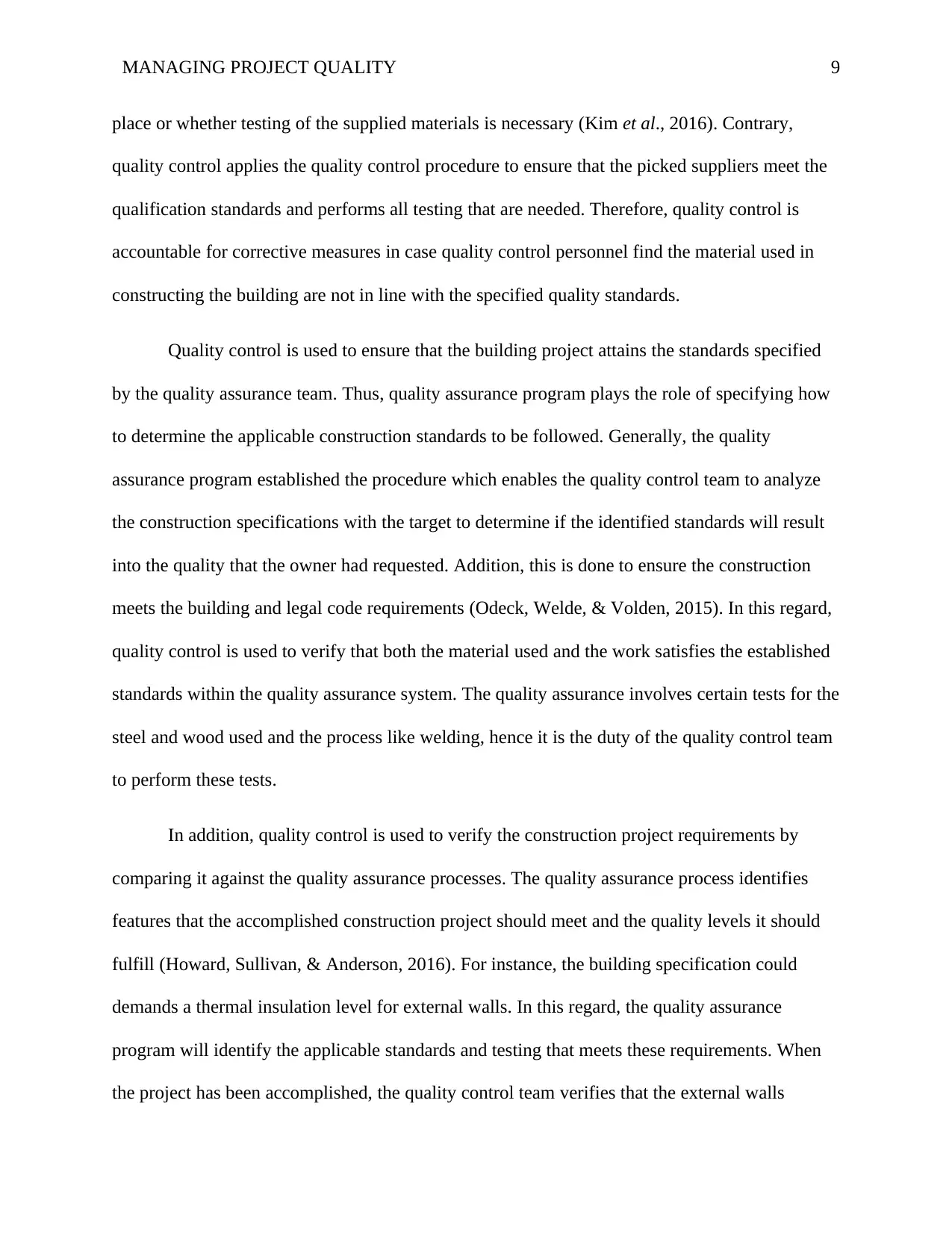
MANAGING PROJECT QUALITY 9
place or whether testing of the supplied materials is necessary (Kim et al., 2016). Contrary,
quality control applies the quality control procedure to ensure that the picked suppliers meet the
qualification standards and performs all testing that are needed. Therefore, quality control is
accountable for corrective measures in case quality control personnel find the material used in
constructing the building are not in line with the specified quality standards.
Quality control is used to ensure that the building project attains the standards specified
by the quality assurance team. Thus, quality assurance program plays the role of specifying how
to determine the applicable construction standards to be followed. Generally, the quality
assurance program established the procedure which enables the quality control team to analyze
the construction specifications with the target to determine if the identified standards will result
into the quality that the owner had requested. Addition, this is done to ensure the construction
meets the building and legal code requirements (Odeck, Welde, & Volden, 2015). In this regard,
quality control is used to verify that both the material used and the work satisfies the established
standards within the quality assurance system. The quality assurance involves certain tests for the
steel and wood used and the process like welding, hence it is the duty of the quality control team
to perform these tests.
In addition, quality control is used to verify the construction project requirements by
comparing it against the quality assurance processes. The quality assurance process identifies
features that the accomplished construction project should meet and the quality levels it should
fulfill (Howard, Sullivan, & Anderson, 2016). For instance, the building specification could
demands a thermal insulation level for external walls. In this regard, the quality assurance
program will identify the applicable standards and testing that meets these requirements. When
the project has been accomplished, the quality control team verifies that the external walls
place or whether testing of the supplied materials is necessary (Kim et al., 2016). Contrary,
quality control applies the quality control procedure to ensure that the picked suppliers meet the
qualification standards and performs all testing that are needed. Therefore, quality control is
accountable for corrective measures in case quality control personnel find the material used in
constructing the building are not in line with the specified quality standards.
Quality control is used to ensure that the building project attains the standards specified
by the quality assurance team. Thus, quality assurance program plays the role of specifying how
to determine the applicable construction standards to be followed. Generally, the quality
assurance program established the procedure which enables the quality control team to analyze
the construction specifications with the target to determine if the identified standards will result
into the quality that the owner had requested. Addition, this is done to ensure the construction
meets the building and legal code requirements (Odeck, Welde, & Volden, 2015). In this regard,
quality control is used to verify that both the material used and the work satisfies the established
standards within the quality assurance system. The quality assurance involves certain tests for the
steel and wood used and the process like welding, hence it is the duty of the quality control team
to perform these tests.
In addition, quality control is used to verify the construction project requirements by
comparing it against the quality assurance processes. The quality assurance process identifies
features that the accomplished construction project should meet and the quality levels it should
fulfill (Howard, Sullivan, & Anderson, 2016). For instance, the building specification could
demands a thermal insulation level for external walls. In this regard, the quality assurance
program will identify the applicable standards and testing that meets these requirements. When
the project has been accomplished, the quality control team verifies that the external walls
⊘ This is a preview!⊘
Do you want full access?
Subscribe today to unlock all pages.

Trusted by 1+ million students worldwide
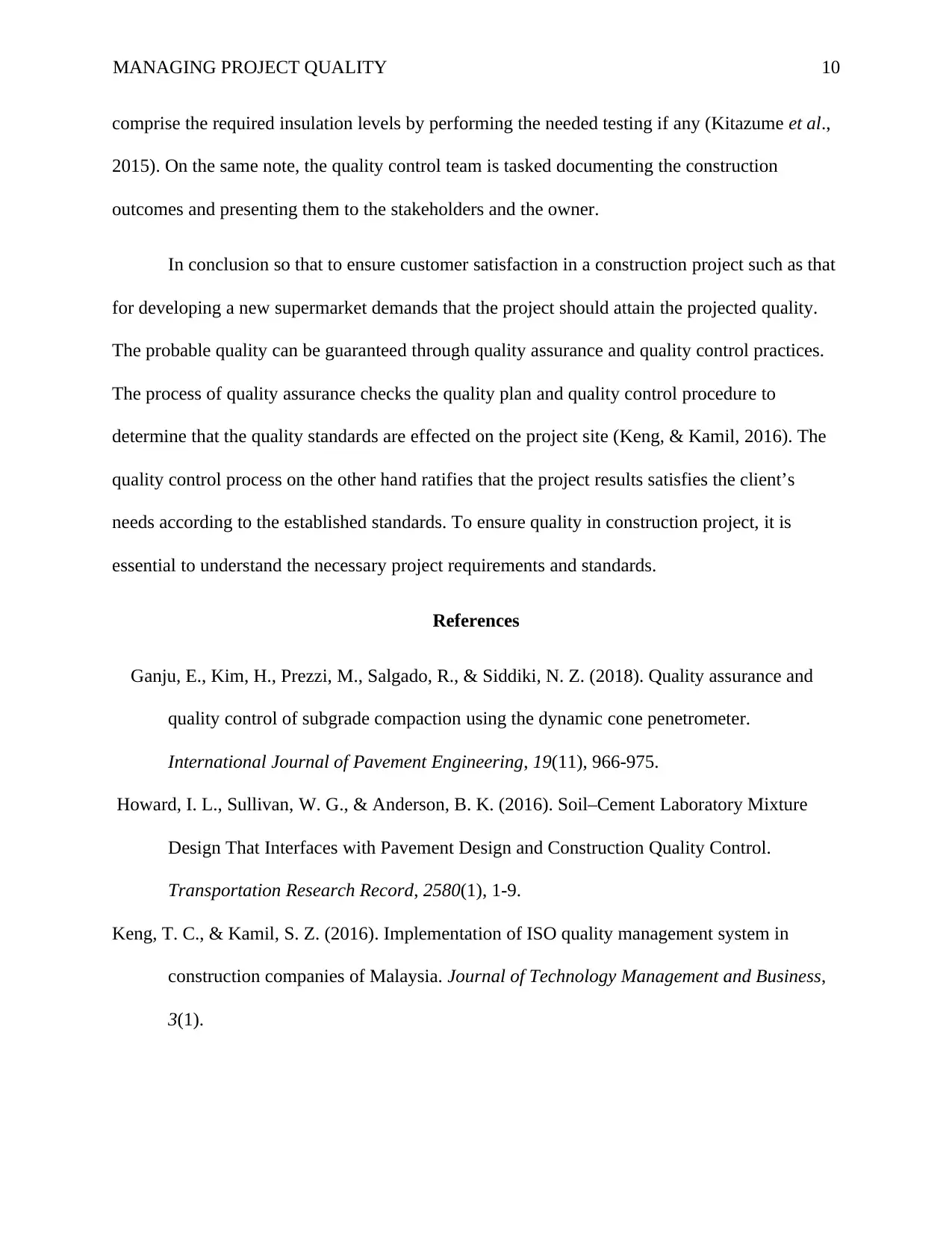
MANAGING PROJECT QUALITY 10
comprise the required insulation levels by performing the needed testing if any (Kitazume et al.,
2015). On the same note, the quality control team is tasked documenting the construction
outcomes and presenting them to the stakeholders and the owner.
In conclusion so that to ensure customer satisfaction in a construction project such as that
for developing a new supermarket demands that the project should attain the projected quality.
The probable quality can be guaranteed through quality assurance and quality control practices.
The process of quality assurance checks the quality plan and quality control procedure to
determine that the quality standards are effected on the project site (Keng, & Kamil, 2016). The
quality control process on the other hand ratifies that the project results satisfies the client’s
needs according to the established standards. To ensure quality in construction project, it is
essential to understand the necessary project requirements and standards.
References
Ganju, E., Kim, H., Prezzi, M., Salgado, R., & Siddiki, N. Z. (2018). Quality assurance and
quality control of subgrade compaction using the dynamic cone penetrometer.
International Journal of Pavement Engineering, 19(11), 966-975.
Howard, I. L., Sullivan, W. G., & Anderson, B. K. (2016). Soil–Cement Laboratory Mixture
Design That Interfaces with Pavement Design and Construction Quality Control.
Transportation Research Record, 2580(1), 1-9.
Keng, T. C., & Kamil, S. Z. (2016). Implementation of ISO quality management system in
construction companies of Malaysia. Journal of Technology Management and Business,
3(1).
comprise the required insulation levels by performing the needed testing if any (Kitazume et al.,
2015). On the same note, the quality control team is tasked documenting the construction
outcomes and presenting them to the stakeholders and the owner.
In conclusion so that to ensure customer satisfaction in a construction project such as that
for developing a new supermarket demands that the project should attain the projected quality.
The probable quality can be guaranteed through quality assurance and quality control practices.
The process of quality assurance checks the quality plan and quality control procedure to
determine that the quality standards are effected on the project site (Keng, & Kamil, 2016). The
quality control process on the other hand ratifies that the project results satisfies the client’s
needs according to the established standards. To ensure quality in construction project, it is
essential to understand the necessary project requirements and standards.
References
Ganju, E., Kim, H., Prezzi, M., Salgado, R., & Siddiki, N. Z. (2018). Quality assurance and
quality control of subgrade compaction using the dynamic cone penetrometer.
International Journal of Pavement Engineering, 19(11), 966-975.
Howard, I. L., Sullivan, W. G., & Anderson, B. K. (2016). Soil–Cement Laboratory Mixture
Design That Interfaces with Pavement Design and Construction Quality Control.
Transportation Research Record, 2580(1), 1-9.
Keng, T. C., & Kamil, S. Z. (2016). Implementation of ISO quality management system in
construction companies of Malaysia. Journal of Technology Management and Business,
3(1).
Paraphrase This Document
Need a fresh take? Get an instant paraphrase of this document with our AI Paraphraser
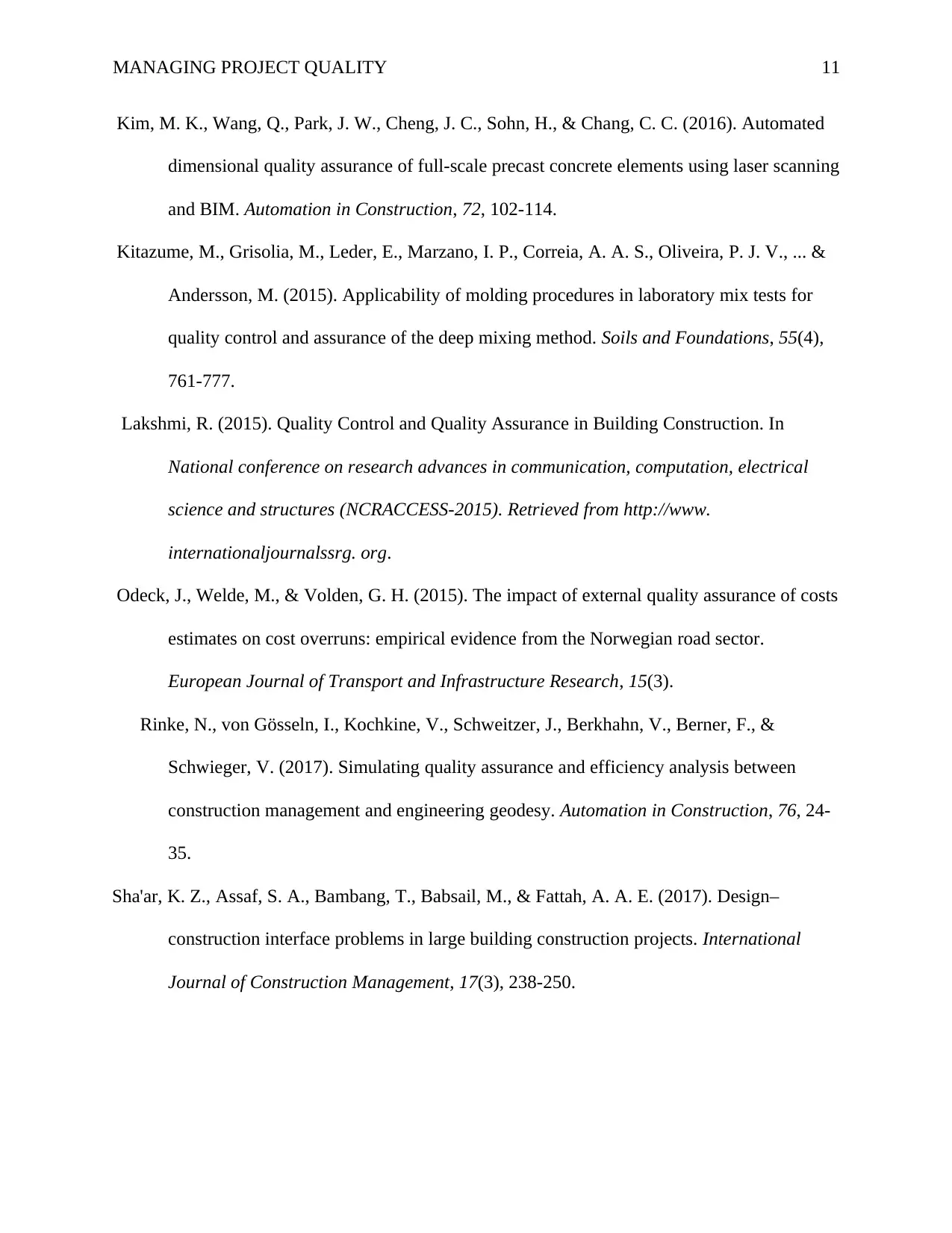
MANAGING PROJECT QUALITY 11
Kim, M. K., Wang, Q., Park, J. W., Cheng, J. C., Sohn, H., & Chang, C. C. (2016). Automated
dimensional quality assurance of full-scale precast concrete elements using laser scanning
and BIM. Automation in Construction, 72, 102-114.
Kitazume, M., Grisolia, M., Leder, E., Marzano, I. P., Correia, A. A. S., Oliveira, P. J. V., ... &
Andersson, M. (2015). Applicability of molding procedures in laboratory mix tests for
quality control and assurance of the deep mixing method. Soils and Foundations, 55(4),
761-777.
Lakshmi, R. (2015). Quality Control and Quality Assurance in Building Construction. In
National conference on research advances in communication, computation, electrical
science and structures (NCRACCESS-2015). Retrieved from http://www.
internationaljournalssrg. org.
Odeck, J., Welde, M., & Volden, G. H. (2015). The impact of external quality assurance of costs
estimates on cost overruns: empirical evidence from the Norwegian road sector.
European Journal of Transport and Infrastructure Research, 15(3).
Rinke, N., von Gösseln, I., Kochkine, V., Schweitzer, J., Berkhahn, V., Berner, F., &
Schwieger, V. (2017). Simulating quality assurance and efficiency analysis between
construction management and engineering geodesy. Automation in Construction, 76, 24-
35.
Sha'ar, K. Z., Assaf, S. A., Bambang, T., Babsail, M., & Fattah, A. A. E. (2017). Design–
construction interface problems in large building construction projects. International
Journal of Construction Management, 17(3), 238-250.
Kim, M. K., Wang, Q., Park, J. W., Cheng, J. C., Sohn, H., & Chang, C. C. (2016). Automated
dimensional quality assurance of full-scale precast concrete elements using laser scanning
and BIM. Automation in Construction, 72, 102-114.
Kitazume, M., Grisolia, M., Leder, E., Marzano, I. P., Correia, A. A. S., Oliveira, P. J. V., ... &
Andersson, M. (2015). Applicability of molding procedures in laboratory mix tests for
quality control and assurance of the deep mixing method. Soils and Foundations, 55(4),
761-777.
Lakshmi, R. (2015). Quality Control and Quality Assurance in Building Construction. In
National conference on research advances in communication, computation, electrical
science and structures (NCRACCESS-2015). Retrieved from http://www.
internationaljournalssrg. org.
Odeck, J., Welde, M., & Volden, G. H. (2015). The impact of external quality assurance of costs
estimates on cost overruns: empirical evidence from the Norwegian road sector.
European Journal of Transport and Infrastructure Research, 15(3).
Rinke, N., von Gösseln, I., Kochkine, V., Schweitzer, J., Berkhahn, V., Berner, F., &
Schwieger, V. (2017). Simulating quality assurance and efficiency analysis between
construction management and engineering geodesy. Automation in Construction, 76, 24-
35.
Sha'ar, K. Z., Assaf, S. A., Bambang, T., Babsail, M., & Fattah, A. A. E. (2017). Design–
construction interface problems in large building construction projects. International
Journal of Construction Management, 17(3), 238-250.
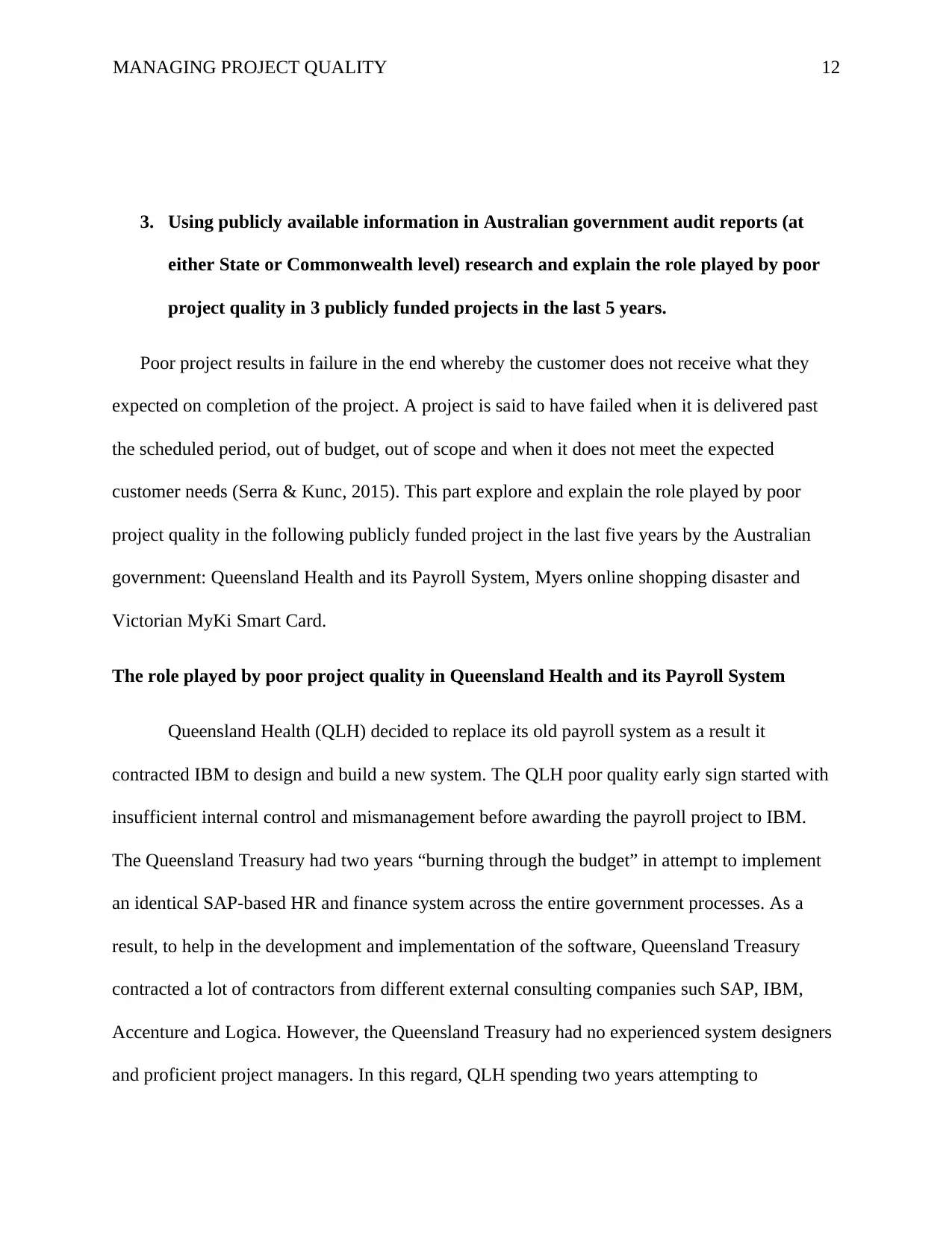
MANAGING PROJECT QUALITY 12
3. Using publicly available information in Australian government audit reports (at
either State or Commonwealth level) research and explain the role played by poor
project quality in 3 publicly funded projects in the last 5 years.
Poor project results in failure in the end whereby the customer does not receive what they
expected on completion of the project. A project is said to have failed when it is delivered past
the scheduled period, out of budget, out of scope and when it does not meet the expected
customer needs (Serra & Kunc, 2015). This part explore and explain the role played by poor
project quality in the following publicly funded project in the last five years by the Australian
government: Queensland Health and its Payroll System, Myers online shopping disaster and
Victorian MyKi Smart Card.
The role played by poor project quality in Queensland Health and its Payroll System
Queensland Health (QLH) decided to replace its old payroll system as a result it
contracted IBM to design and build a new system. The QLH poor quality early sign started with
insufficient internal control and mismanagement before awarding the payroll project to IBM.
The Queensland Treasury had two years “burning through the budget” in attempt to implement
an identical SAP-based HR and finance system across the entire government processes. As a
result, to help in the development and implementation of the software, Queensland Treasury
contracted a lot of contractors from different external consulting companies such SAP, IBM,
Accenture and Logica. However, the Queensland Treasury had no experienced system designers
and proficient project managers. In this regard, QLH spending two years attempting to
3. Using publicly available information in Australian government audit reports (at
either State or Commonwealth level) research and explain the role played by poor
project quality in 3 publicly funded projects in the last 5 years.
Poor project results in failure in the end whereby the customer does not receive what they
expected on completion of the project. A project is said to have failed when it is delivered past
the scheduled period, out of budget, out of scope and when it does not meet the expected
customer needs (Serra & Kunc, 2015). This part explore and explain the role played by poor
project quality in the following publicly funded project in the last five years by the Australian
government: Queensland Health and its Payroll System, Myers online shopping disaster and
Victorian MyKi Smart Card.
The role played by poor project quality in Queensland Health and its Payroll System
Queensland Health (QLH) decided to replace its old payroll system as a result it
contracted IBM to design and build a new system. The QLH poor quality early sign started with
insufficient internal control and mismanagement before awarding the payroll project to IBM.
The Queensland Treasury had two years “burning through the budget” in attempt to implement
an identical SAP-based HR and finance system across the entire government processes. As a
result, to help in the development and implementation of the software, Queensland Treasury
contracted a lot of contractors from different external consulting companies such SAP, IBM,
Accenture and Logica. However, the Queensland Treasury had no experienced system designers
and proficient project managers. In this regard, QLH spending two years attempting to
⊘ This is a preview!⊘
Do you want full access?
Subscribe today to unlock all pages.

Trusted by 1+ million students worldwide
1 out of 26
Your All-in-One AI-Powered Toolkit for Academic Success.
+13062052269
info@desklib.com
Available 24*7 on WhatsApp / Email
![[object Object]](/_next/static/media/star-bottom.7253800d.svg)
Unlock your academic potential
Copyright © 2020–2025 A2Z Services. All Rights Reserved. Developed and managed by ZUCOL.


